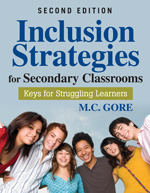Preface
Acknowledgments
About the Author
1. The Letters Behind the Book
Universal Design for Learning
A Note About People First Language
2. The Locks on the Doors to Learning
The Information Processing/Retention Locks
The Sum Total of the Locks
3. Keys to the Effectiveness of the Inclusion Strategies
Dual Coding Theory and Tri-Coding of Information
4. Ensuring Students Understand Instructions
Key 1: Gain Students' Attention with Attentional Cues
Key 2: Providing Written and Oral Instructions
Key 3: Repeat Instructions
Key 4: Chunking Instructions
Key 5: Tell-Backs and Show-Mes
5. Teaching the Concepts and Vocabulary of Our Disciplines Strategies
Key 7: Semantic Feature Analysis Matrix
Key 8: Compare and Contrast Vocabulary Mix
Key 10: Word Analysis Diagram
Key 12: Quick Sketching a Definition
Key 13: Total Physical Response and Vocabulary Drama
Key 14: Keyword Mmemonic Strategy
Key 15: Teaching Greek and Latin Morphemes
Key 16: Vocabulary Word Card Ring
Key 17: Vocabulary Word Wall
6. Teaching Devices for Increasing Student Learning From Lectures
Key 20: Simply Slowing Down
Key 22: Cueing Critical Points
Key 23: Explicitly Teaching the Big Ideas
Key 24: Providing an Advance Organizer
Key 25: Soliciting Students' Examples
Key 26: Providing a Plethora of Examples
Key 27: Providing Nonexamples
Key 29: Role Playing Difficult Content
7. Increasing Learning by Using Note Taking Strategies
Key 30: Teaching Abbreviations
Key 31: Teach Summarizing
Key 32: Partial Graphic Organizer Notes
Key 35: Brick and Mortar Notes
Key 36: Three-Column Perzonalized Notes
8. Promoting Student Learning From the Textbook
Key 38: Using GOs to Make Relationships Explicit
Key 39: Pre-Teaching Vocabulary
Key 40: Explicitly Teaching Text Structure
Key 41: Accessible Digital Textbooks
9. Increasing Learning by Using Textbook Guides
Key 42: Main Idea Text Structure Study Guide
Key 43: List Text Structure Study Guide
Key 44: Order Text Structure Study Guide
Key 45: Compare and Contrast Text Structure Study Guide
Key 46: Cause and Effect Text Structure Study Guide
Key 47: Problem Solution Study Guide
Key 48: Analogy Study Guide
10. Promoting Factual Mastery Through Mnemonic Devices
Key 49: Keyword Mmemonics with Narrative Chains
Key 50: Musical Mmemonisc
11. Improving Higher-Order Thinking Skills
Key 51: Storyboards Type 1
Key 52: Storyboards Type 2
Key 54: Venn-Euler Diagram
Key 55: Reasoning by Metaphor and Analogy
Key 56: Compare and Contrast Matrix
Key 57: Campfire Metaphor for Cause and Effect
Key 58: Evaluation by Elimination by Aspects Matric
Key 59: Evaluation by Addition Matrix
12. Improving the Quality of Expository Writing
Key 60: Teaching Summarizing
Key 61: Teaching Text Structure
Key 64: Data Revival Chart
Key 65: Adapted Evaluation Matrices
Key 66: Graphic Organizers for Expository Writing
13. Future Keys
Future Key #1: fMRI-Supported Learning Strategies
Future Key #2: Virtual Reality
Future Key #3: Podcasting
Future Key #4: Videogame-Based Learning
Future Key#5: Videoconference Tutoring
References
Index




